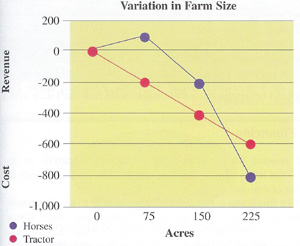Economics of Farming with Horses:
Farm Size** (part 4 of 7)
Before concluding that farming with horses is economically sound, let's look at the effect of farm size. A key point is, how many horses can one teamster work at a time? More that one is certain. In maintaining a conservative approach, I assume that one teamster can comfortably work up to six horses at a time.
The tractor operator and the first teamster own the farm and take their wages from farm profits. Tractor size may be increased without adding hired labor to operate the tractor. More teamsters, however, need to be hired as the farm size increases beyond what is workable by the owner/teamster and six horses.
By holding our assumed values constant, we can simplify our formula to determine the range of farm sizes suitable for the use of horse power versus tractor power.
The 40-year career cost of using a tractor is 7333+F(1707+800xD), where F is the farm size and D is the price of diesel fuel per gallon.
The 40-year career cost of using horses, where F is the farm size and A is the labor rate in $ per hour:
| Acres | Teamsters | Horses | Cost |
|---|---|---|---|
| 0-75 | 1 | 1-6 | F(160xA-1804) |
| 76-150 | 1-2 | 7-12 | -63,300+(F-75)x(960xA-1804) |
| 151-225 | 2-3 | 13-18 | 233,400+(F-150)x(1760xA-1804) |
| 226-300 | 3-4 | 19-24 | 890,100+(F-225)x(2560xA-1804) |
| 301-375 | 4-5 | 25-30 | 1,906,800+(F-300)x(3360xA-1804) |

Given the values of
A = $6.00 and
D = $ 1.00,
then setting the tractor and horse functions equal to each other and solving for F, we find that they equate in the third horse function of 150 to 225 acres at a farm size of 174 acres. Meaning that at 174 acres the farmer would switch from horses to a tractor as the source of traction. In real life a transition range would be applicable and such a switch at precisely 174 acres would be unlikely, but this method gives us a general range of farm size where using draft horses for traction power may at least be considered.![]()
Assumptions
Career Cost of Horses versus Tractor
Practicalities
Operational Cost for Horses
Debt Financing
**Because Chet Kendell wrote this economic comparison of tractor versus horse farming in 2005, the figures will need to be adjusted to reflect present values. That said, we believe its fundamental conclusion, that tractor farming incorporates a negative cost function that decreases profits while horse farming includes a livestock production function that boosts its economic outcome.
Chet Kendell was on the Economics faculty at Brigham Young University - Idaho in Rexburg. He currently owns Kendell Innovative Dairy Systems LLC in Idaho and lives, farms and writes with his family in Ashton, Idaho. This article appeared in the Spring 2005 issue of Rural Heritage.
